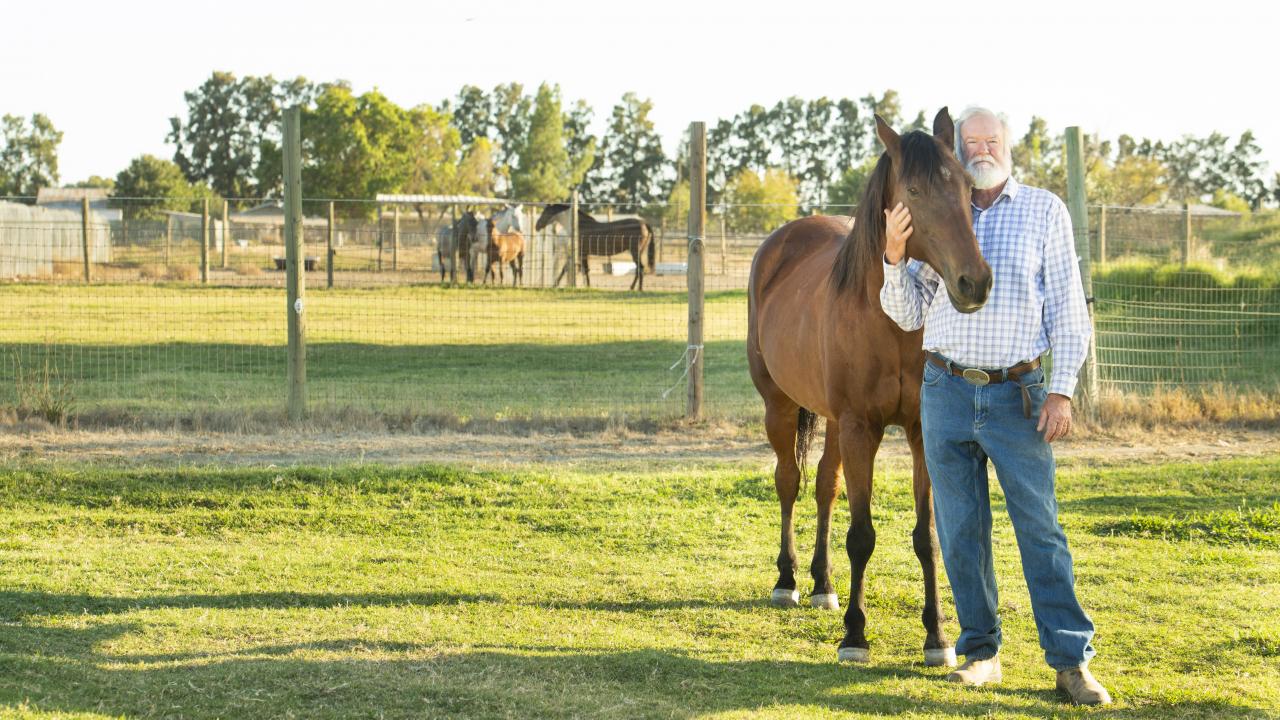
Taking Equine Critical Care to New Heights
Following a normal morning feeding, Easy, a 19-year-old Missouri Fox Trotter gelding, was found down and rolling in his pasture (a sign of a potential colic problem). Having been clients of the UC Davis veterinary hospital for more than 30 years, owners Meredith Reinhart and Mark McLean knew exactly who to call. They made arrangements for veterinarians and students from the nearby UC Davis School of Veterinary Medicine to come see Easy. The school quickly dispatched its Equine Field Service, who examined Easy and administered medication to relieve pain and abdominal cramping. But when Field Service had to return three hours later because Easy continued to be painful, they weren’t taking any chances and made arrangements to have Easy transported back to the veterinary hospital.
Colic is a broad term for abdominal discomfort that can manifest in many ways in horses. It’s a condition that all horse owners are familiar with, and one that equine surgeons never take lightly. Severe cases—like Easy’s turned out to be—require emergency surgery, and can be fatal if not treated immediately.
Once at the hospital, Easy was admitted to the Intensive Care Unit (ICU) for monitoring and intravenous (IV) fluid therapy. Despite being medicated, Easy continued to want to be down and rolling in his stall – sings of severe pain. He was taken into emergency surgery where Dr. Isabelle Kilkoyne discovered a lipoma (fatty lump) that was strangulating the upper part of his small intestine. Dr. Kilcoyne was able to successfully resect the area of the lipoma. Following surgery, Easy was returned to the ICU for close monitoring, as well as treatment with more IV fluids and anti-inflammatory medications.

Survival rates for colic patients have greatly improved over the past 20 years. While the university has not calculated current colic surgery success rates, a retrospective study from 2004-2009 showed that UC Davis maintained a success rate above 90 percent in the nearly 100 colic surgeries it performed each year during that timeframe. This rate was 3 percent higher than the worldwide published data on colic surgeries at that time. Additionally, the hospital is able to treat approximately 70 percent of its patients without requiring surgery at all.
Surgical methods typically involve a manual untwisting of the intestine or possible resection if the twisting has irreparably damaged the intestine, as Easy’s did. In cases of intestinal blockage in the gastrointestinal (GI) tract, the objects are surgically removed if the horse is unable to pass the object on its own.
These types of impaction within the GI tract are typically caused by feed, enteroliths, worms, and sand. In addition to impaction, other types of colic include gas colic, intussusception (in which the intestine slides into itself), inflammation of the intestine (called enteritis), gastric rupture, or even a twist in the gut, which is considered one of the most lethal forms of colic.
Emergency services are available at the UC Davis veterinary hospital 24 hours a day, including weekends and holidays, to meet colic complaints and other emergency needs. In the coming years, the school looks to raise the level of its emergency services for equines.
An Equine Surgery & Critical Care Center (ESCCC) is being planned as part of the new Veterinary Medical Center at UC Davis. This new facility will allow surgeons to enhance their offerings of the most progressive techniques available for patients like Easy. The operating rooms will be built in close proximity to the Intensive Care Unit (ICU), for those critical situations when seconds count to save a horse. The ESCCC surgical suites will be built to best suit the most cutting-edge approaches to injuries, including minimally-invasive procedures such as arthroscopy, laparoscopy, thoracoscopy, endoscopic laser surgery and lithotripsy. These techniques will lessen tissue damage encountered in traditional methods and reduce recovery time following surgery.
As evidenced with the colic surgery success rates, the emergency surgery team holds high standards in their pursuit of that excellence. New facilities will create opportunities for them to be innovative and improve their care even more. The ESCCC will provide a facility in which the current excellent care will not only continue, but will expand to incorporate advancements to take equine critical care to the next level.
“We look for a new Equine Surgery and Critical Care Center to make our care of critical patients easier and more efficient,” said Dr. Julie Dechant, chief of the Equine Emergency Surgery and Critical Care Service. “It will allow better use of technology for patient monitoring than in our current facilities. We do a good job of that currently, but we aren’t working in purpose-made ICU facilities, which this will be.”
Easy recovered well, as Reinhart and McLean followed a strict 90-day recovery process that gradually allowed Easy more movement and larger spaces to occupy. Following that rehabilitation period, Easy—who is McLean’s primary riding horse—was able to continue trail rides with the rest of the herd, currently at seven horses.
“While not the ‘boss hoss,’ Easy is the heart of the herd,” said Reinhart. “He’s the first horse we let the foals interact with—other than their mothers, of course—when we are ready to introduce them to other horses.”
Easy is back to his old self, and Reinhart and McLean look forward to many more years riding and enjoying him. They have owned other horses that lived into their late 20s, so they hope for the same with Easy.
# # #
